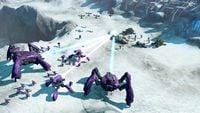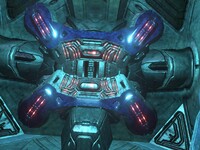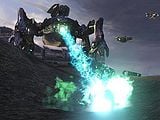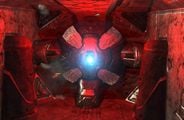Deutoros-pattern Scarab: Difference between revisions
From Halopedia, the Halo wiki
m (Reverted edits by 68.114.71.158 (Talk) to last version by DinoBenn) |
|||
| Line 100: | Line 100: | ||
=== ''Halo Wars'' === | === ''Halo Wars'' === | ||
[[Image:Two_Scarabs.jpg|right|thumb|The Scarab from ''Halo Wars'' attacking the UNSC with smaller units beside it.]] | [[Image:Two_Scarabs.jpg|right|thumb|The Scarab from ''Halo Wars'' attacking the UNSC with smaller units beside it.]] | ||
The Scarabs in ''Halo Wars'' seem to be | The Scarabs in ''Halo Wars'' seem to be a different version of both the Halo 2 and Halo 3 counterparts with new back legs and a bulkier chassis, with the main assualt beam placed on the tip of the Scarab rather then under the hull. The legs also no longer contain light armor flaps as well. | ||
A recent article in ''Xbox Magazine'' comments that an attacking Scarab "ripped [a UNSC base] a new one." Scarabs are very slow and expensive to build (3,000 resources and 20 population in Skirmish), with no upgrades available due to their cost.<ref>http://www.halowars.com/GameInfo/Citadel.aspx#Scarab</ref> They excel at attacking vehicles with their powerful weapons, and they work well against infantry. | A recent article in ''Xbox Magazine'' comments that an attacking Scarab "ripped [a UNSC base] a new one." Scarabs are very slow and expensive to build (3,000 resources and 20 population in Skirmish), with no upgrades available due to their cost.<ref>http://www.halowars.com/GameInfo/Citadel.aspx#Scarab</ref> They excel at attacking vehicles with their powerful weapons, and they work well against infantry. | ||
Revision as of 23:48, February 10, 2010
The Type-47 Ultra Heavy Assault Platform, more commonly known as the Scarab, is a Covenant mining vehicle adapted for use in combat.
Introduction
Developed in an advanced construction site, Scarabs are mobile fortresses. The quadrupedal behemoths are typically deployed from low- or medium orbit, or from high atmosphere. They are used to attack heavily-defended structures, and often lend quick but unstoppable support to Covenant troops on the ground.
Scarabs are extremely powerful, possessing an exceptionally powerful plasma beam (mounted onto its "head") as well as one or two dorsally-mounted anti-air cannons. Their "bodies" are massive and multi-level, and they possess four legs. Unlike most Covenant vehicles, Scarabs do not use anti-gravity propulsion to move. Scarabs instead walk using their massive legs, which are surprisingly swift and precise given their size. The legs can also be used to crush enemy forces on the ground. It is thought that some amount of anti-gravity propulsion is used to reduce stresses on the legs.
Despite their enormous strength, however, Scarabs are quite vulnerable to being boarded; a Scarab's central core is protected only by the vehicle's external armor, so attacking the core is easy once an enemy boards the craft. A Scarab will also be temporarily stalled if its legs sustain enough damage, allowing a would-be boarder to simply jump into the vehicle's troop bay. To counter this, Scarabs typically carry squads of Grunts and Jackals, as well as some Brutes and Elites.
Scarabs have been used in many battles during the Human-Covenant War, including the Battle of Reach, the Battle of Earth and the Battle of the Ark, usually to great effect.[1]
Variations
Halo Graphic Novel
In the Halo Graphic Novel, the Scarab had a very different appearance from the two game variants with a roughly cross shaped body. The front and back both bore dual cannons, and neither end had a visible plasma beam. It appears to be roughly based on concept art by Shi Kai Wang.
Its legs were a distinctly different shape (straight, with an "L"-shaped joint to the body). It should be noted, however, that the story in which it appears, Second Sunrise Over New Mombasa, uses a very large amount of artistic license. The story is canonical (it was authorized by Bungie), but the visuals of the story clearly are not.
Halo 2
The Scarab was first seen in Halo 2 level Outskirts, where it appeared as a large, four-legged, silver-armored behemoth with an estimated height of ninety feet. It featured an upper deck that was guarded by numerous Elites, Jackals, and Grunts, along with a walkway going over the entrance to the control room. This model is manned by a traditional crew, rather than being controlled by Lekgolo worms.
Scarabs' shells were invulnerable to damage from 90mm shells, 102mm shaped charges,.50 caliber rounds, and ANVIL HE missiles; the armor could be similar to the plating used on Covenant warships. In addition to the vehicle's main gun, a large anti-aircraft plasma weapon is mounted on top of the walkway; this weapon was used to neutralize the Pelicans ferrying John-117 and his strike team while en route to Regret's Assault Carrier.
The model featured in Halo 2 is often theorized to be a dedicated excavation platform, in contrast to the more combat-ready model featured in Halo 3, Halo Wars, and Halo 3: ODST, as it lacks many of the onboard weapons featured on the other model. Its size makes it considerably less maneuverable than the smaller variant, preventing it from engaging fast-moving targets while confined in narrow areas, such as city streets. This handicap leaves it succeptible to boarding actions. During the Battle of Mombasa, John-117 was able to board such a Scarab with help from Marines of the 405th. Once aboard, the Spartan eliminated all Covenant troops on the deck and in the control room; he then detonated the assault platform from within, presumably by overloading the engine core.
In the final level, The Great Journey, the Arbiter attempts to hijack a Scarab with the intent to break into Delta Halo's Control Room. Sergeant Johnson gets to the Scarab first, however. Since both he and the Arbiter intend to keep the Halo from being activated, they agree to work together. After fighting through numerous Banshees, Wraiths and other Loyalist opposition, Johnson blasts open the door to Control Room and then abandons the Scarab, since it had served its purpose.
Halo 3 (Scarab V2)
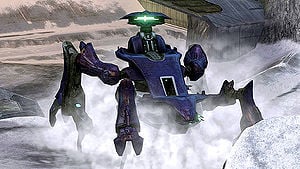
In Halo 3, the Scarab underwent major changes. Unlike its Halo 2 predecessor, the Halo 3 Scarab tank is now completely destructible. Its appearance has been completely altered, with a differently-shaped body and a more bulbous end. It seems to be shorter but wider, and it is purple rather than silver and blue. The legs appear to be more capable of sustaining a high impact. The Halo 3 Scarabs are piloted by Lekgolo worms, whereas the Halo 2 Scarabs were piloted by Covenant infantry.
In terms of weaponry, the Halo 3 Scarab's plasma beam is smaller and seemingly weaker; on Legendary, the Halo 3 beam takes almost a full second to kill a player, while in Halo 2, the beam is instantly fatal. The beam also looks more hose-like, whereas the beam in Halo 2 was a straight line. The two anti-air turrets on the Halo 2 Scarab have been replaced by a single, larger turret on the craft's rear. The flaps on the plasma beam were replaced with two destructible stationary plates.
As pointed out before, the Scarab now appears to have no crew controlling it, just guards, to keep boarders off, and it is controlled by Lekgolo worms.[2] Also while shooting exposed Lekgolo worms the worms will bleed, although the blood will not show on the ground. This has been proven in the December issue of Game Informer, in an article on the Mythic map pack. The level Assembly was shown to be a Scarab factory, and it was stated that tubes could be clearly seen on the level, injecting the worms into the Scarab shells.
Scarabs in Halo 3 are controlled by NPC AIs, unlike the Halo 2 Scarabs, whose paths were scripted. Halo 3 Scarabs also leak a green fluid from their main guns; this is most likely inflammatory fluid (as the Scarab's weapon is probably similar to a Hunter's assault beam).
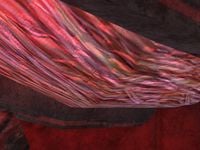
A likely conjecture is that this version of the Scarab was intended to be a weapon. Its color changed to a shade of purple, like other Covenant war-ready vehicles, and it was better-defended and more heavily armed. It has been speculated that Scarabs of Halo 2 were not weapons, but rather mining tools that were deployed as emergency combat relief by Regret upon finding humans on Earth. They could have been the mining Scarabs from Halo: The Fall of Reach. This is supported by the fact that Regret was looking for the Artifact that opened the portal to the Ark, and he needed digging machines to excavate it.
Differences aside, it still had many similarities to the old Scarab. There were three levels (or decks), and the lowest was accessible when the Scarab had been temporarily disabled. This level featured a rear-mounted plasma turret, and usually one to four Brutes, depending on the difficulty level. There was a ramp that led to the second level, where there were a varying number of enemies, depending on the level and difficulty. Usually, you could expect to find a few Brutes and Grunts. On this level, there were two more plasma turrets, aimed to either side of the Scarab. If you turned 180° immediately upon ascending the ramp to this level, you could go up the purple slope to the third tier. This was just an open, unprotected platform below the large turret. Past the turrets on the second level (round the corner) is the power core that must be destroyed to kill the Scarab. Called the Scarab V2 in the Halo Encyclopedia.
Halo Wars
The Scarabs in Halo Wars seem to be a different version of both the Halo 2 and Halo 3 counterparts with new back legs and a bulkier chassis, with the main assualt beam placed on the tip of the Scarab rather then under the hull. The legs also no longer contain light armor flaps as well. A recent article in Xbox Magazine comments that an attacking Scarab "ripped [a UNSC base] a new one." Scarabs are very slow and expensive to build (3,000 resources and 20 population in Skirmish), with no upgrades available due to their cost.[3] They excel at attacking vehicles with their powerful weapons, and they work well against infantry.
Scarabs are extremely difficult to destroy. Overwhelming it with a massive attack force works well, particularly when using anti-vehicle units like the Cobra and Hunter, but a significant portion of the attack force will be lost in the process. Using Professor Anders' Cryo Bomb can decrease the number of casualties. An upgraded UNSC MAC or carpet bomb can destroy a Scarab rather quickly, as can a group of Vultures using their missile barrages. Covenant leader units' special abilities can inflict massive damage on a Scarab, with the Prophet of Regret's Cleansing Beam being a good example.
Scarabs are very mobile, being able to climb over most obstacles. Only certain obstructions, like craters or fire, can block them. Despite their resemblance to the Halo 3 Scarab, being controlled by Lekgolo worms, an Elite or Brute will respond to orders given to the Scarab. This is likely due to the fact that the scarab has a few crew members.
Since Scarabs count as twenty population and cost 3,000 resources, up to 2 can be spawned at a time in a Standard Skirmish and four in Deathmatch mode; a base increases a player's population limit by ten, with the absolute maximum limit being ninety-nine.
Like Vultures, Scarabs cannot be jacked by Spartan units, with the only exception being an abandoned Scarab being attacked by the flood in Beachhead. Commandeering this Scarab and using it to destroy 25 enemy units will unlocks the achievement Beaming with Pride.
Super Scarab
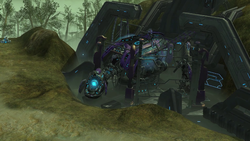
There is a large, incomplete Scarab in the seventh Campaign mission. It is substantially larger and more armored than a standard Scarab, and it appears to be completely mechanical. Its weakness is that there is a beam of light that it projects that shows where its attention is currently focused. To slow down the speed of its searchlight, the player must destroy seven power nodes. It has an extremely high amount of hit points, able to sustain fire from up to nine MAC rounds on the easiest difficulty. It should also be noted that the abandoned Scarab in Beachhead is referred to as Super Scarab, though it seems to be a normal Scarab in every regard but title. This may just be another of Ensemble's mistakes in scripting. Another possible explanation is that this was an excavation scarab (as seen in Halo 2) under construction. This mostly comes from the similarities in the two's chassis.
The Scarab is also being constructed in what looks like the outside of a Forerunner relic, meaning that the Covenant may have been using Forerunner technology to upgrade the Scarab before UNSC forces destroyed the machine. It is also possible that they were using the power to "super-charge" the beam.
Destructible Parts
Halo 2
The Halo 2 Scarab was almost indestructible and immune to damage in the game. Its movement was entirely scripted, and no damageable parts appear to have been coded for it. It was only destroyed in a cutscene. It should also be noted that the Scarab in the level The Great Journey seemed to be damaged under the main gun; as it fired, green fluid (Possibly coolant) leaked out onto the ground, but this could be because of the firing of the gun left residue.
The forward plasma turret could be destroyed with just a few melee attacks, as could the rear plasma turret. The flaps on the main gun could be destroyed only by using a Scorpion tank. Also, the underside grate could be destroyed. And it is simple to operate since even a human can operate the unit.
Halo 3
Halo 3 Scarabs have far more destructible parts then their Halo 2 predecessors. Destructible armor covers each joint of a Scarab's legs. The flaps covering the main gun can be destroyed, though this does not affect the gun's operation. The crest on and around the rear anti-air turret can be completely blown off, slowing the turret's rate of fire and reducing the size of its plasma bolts. Two side door panels near the bottom of the Scarab's rear can be torn off, allowing entry onto the vehicle.
A Scarab's rear armor possesses a glowing red circle; inflicting enough damage upon this circle will detach the armor, leaving the Scarab's core exposed. The core itself can be destroyed; its destruction will trigger a massive explosion that blows the scarab into pieces, leaving few parts intact.
Halo 3: ODST
In Halo 3: ODST, a destructible Scarab appears in Kikowani Station, and indestructible Scarabs make a few background appearances in Coastal Highway.
Weaponry
Primary
- (One) Front-Mounted Cannon
- Ammo: Super-Heated Plasma/incendiary, napalm-like fluid; presumably unguided. They have unlimited ammo.
- Rate of Fire: Four second stream; thirty to forty per second
- Movement of cannon: Through careful examination, one can see that the inside gun part seems to move forward from a cradle as the flaps open up.
- Notes: The projectile emitted from the Scarab's main gun emits a neon-green/bluish glow, indicating extremely high temperature. As the gun fires, white, hot liquid pours from the barrel onto the ground. The gun's force is enough to destroy any vehicle smaller than the Scarab in a matter of seconds. Also, on easy or normal difficulty, if you are in a small vehicle (Mongoose, Warthog, Ghost, Chopper) the sheer force of the plasma stream hitting the ground will flip your vehicle if you are close enough. If this happens close to the Scarab it may step on (and destroy) your vehicle.
- Approx. Range: The effective range on a Scarab's main cannon is not exceptionally good, about 650 meters as seen during the Citadel and Cartographer battles, where its attack can easily be evaded if at a distance, but the Halo 3 Scarabs have almost unlimited sight. For example, on the level "The Covenant", even if you glitch out of the invisible barriers with a Hornet and fly until you can barely see one, it will still shoot at you.
Secondary
- Mounted Anti-Aircraft Turrets (two in Halo 2, one in Halo 3)
- Ammo: Super-Heated Plasma, (similar to the shielded plasma cannon) They have unlimited ammo. However, the Halo 3 version appears to fire blue fuel rods.
- Rate of Fire: 150-250 rounds/minute
- Notes: Presumed computer controlled, but a close look indicates that it may be manually controlled. It does wildly spin around when the core is destroyed as if the automatic controls crashed. Could be shot off with little firepower. NOTE: In Halo 3 the anti-aircraft cannon couldn’t be shot off and was invincible. The anti-aircraft gun(s) were unsurprisingly extremely effective against aircraft.
- Approx. Range: These weapons have a much greater range than the primary cannon on the Scarab. They are extremely effective against airborne vehicles, but can also be used against ground-based vehicles, such as Warthogs or Scorpions. They are effective up to approximately 2,4 kilometers, which is a rough but evidence-based conclusion drawn from ships and vehicles with similar weaponry.
Other Weapons
- 3 X Type-52 Directed Energy Support Weapon
- Ammunition Type: Super-Heated Plasma
- Rate of Fire: 300 Rounds/Minute
- Notes: The Three Plasma turrets are used primarily in an anti-infantry role but are also effective against Mongooses and Warthogs and make aircraft such as Hornets keep their distance.
- Feet
- Damage type: Kinetic
- Notes: Anything the scarab steps on is instantly destroyed, due to its intense strength and mass.
Strategies
The Scarab is often killed by boarding or by an air-based attack on its core although bombing runs and orbital bombardment are more effective. Before you can board the vessel from the ground you must attack its legs. This will make it immobile and it will lower its self to the ground. Head to the back of the Scarab and you will find a shielded core. Shoot it or use a grenade. Once it is destroyed, jump off the Scarab and make as much distance from it as possible.
Trivia
- In Halo 3, on the level "The Covenant", two Scarabs are deployed by the Covenant Loyalist's fleet overhead, to defend the Citadel. However, on the previous level "The Ark", Rtas 'Vadum claimed that "Truth's fleet lies in ruins". It could be possible that these were launched by a remaining ship as a last (failed) push to win the battle. Or it could have come from Truth's Forerunner Dreadnought, which was landed at the time. It could have used cargo transports to drop it off.
- The Scarab is one of the only Covenant vehicles that is not named after supernatural beings (like a Ghost, Banshee, Wraith, or Vampire), with the exception of Brute-made vehicles, although a scarab was a mythological Egyptian giant beetle that pushed the sun across the sky. This may be because it is in fact not a war machine but a piece of re-purposed mining equipment. The Locust, a smaller but otherwise similar machine, also shares its name with an insect instead.
- The Scarab gun is a weapon that players can pick up in Halo 2; it looks like a plasma rifle and can be found on the levels "Outskirts" and "Metropolis". It fires the same plasma stream as the Scarab's main gun, never overheats, and can fire continuous rapid fire. The Scarab gun earns you an achievement on Halo 2 Vista.
- At close range, the explosion of a Scarab has enough power to kill a SPARTAN (or anyone else who is close enough). It can be observed that every level on which there is a Scarab also has many vehicles nearby to make a good escape.
- The Halo 3 Scarab was recreated in Halo Actionclix and is the largest figure ever made by Wizkids, the game's creator. A battle-damaged version was released at the 2007 San Diego Comic-Con for $250, which included the Scarab, two outdoor maps, an indoor map (representing the Scarab's interior), four character cards, and rules for both the Scarab and the game itself. A normal one was also released at select retailers in November 2007.
- In a Halo 3 video documentary (ViDoc) about the new Scarab, the art directors stated that the Scarab in Halo 2 had a horrible design; Shi Kai Wang claimed "It looked like a basket with a handle and could go shopping with it."
- A Scarab's explosion is extremely visible, as Rtas 'Vadum remarks how he saw the explosion of a Scarab from orbit, although it is probable that he may have been exaggerating or he was observing the battle through some sort of a telescope. It is also possible that, due to the inclusion of both the Arbiter and the Master Chief in the battle, and the proximity to the map room on Installation 00, that he was paying particular attention to the battle.
- When Sergeant Major Johnson takes control of a Scarab in Halo 2, he finds a way to deploy an energy shield that protected the control room from a boarding party. Apparently the Covenant at New Mombasa either didn't have it, didn't consider the possibility of being boarded, or it could be to allow the crew to walk outside and defend the Scarab and kill the "Demon" pursuing them.
- You get the achievement Beaming with Pride, when you destroy 25 enemy units with a Scarab in mission thirteen of Halo Wars.
- An older screenshot of Halo Wars shows a different Scarab model than the model in the the released game. The old version look very similar to the Halo 2-era Scarab, while the new one looks more like the Halo 3 variant.
- In Halo Wars, if you use the Wuv Woo skull, you can make the Scarab shoot rainbow beams of pure love. This doesn't affect the Super Scarab.
- In Halo 3: ODST, the Halo 3-era Scarabs are present the same day the Halo 2-era Scarab was in the New Mombasa. This can be seen as an inconsistency, but a possible explanation could be that there are two different variants of Scarabs. The variants encountered in Halo 2 could have possibly been deployed for the sole purpose of infantry transportation while the variants encountered in Halo Wars and ODST were designed for intentional ground/air combat.
- In Halo 3, on the level The Ark, if a player stands on the left of a Scarab, it will turn left. Doing the same on the right makes it turn right. This is usually called the "controlling the Scarab" glitch.[4]
Glitches
- In Halo 2, if you jump correctly from the main platform, you can see, shoot and throw grenades through the wall and even see Sergeant Major Johnson holding a plasma pistol in the front.
- In Halo 3, if you jump onto one of the legs of a Scarab, and the leg rises up, it will cause you to fly through the air for a considerable distance and finally die after a while, possibly after hitting a barrier. This can also happen in Halo 3:ODST with a banshee.
- On the level "Outskirts", when you see the Warthog being destroyed by the Scarab, you can grenade jump out of the map and see the Scarab walking away, but it disappears afterwards.
- In Halo 3, on The Ark, a glitch can be used to create an "undead Scarab".[5] When the level's Scarab first appears, it walks past the player and behind a cliff face; when the player makes it to the end of the area, it walks back in. If a player uses a Ghost to board the Scarab while it walks behind the cliff face, they can destroy the Scarab prematurely. From there, another player must simply get to the end of that section, triggering the Scarab's return. The damaged front half of the destroyed Scarab will walk out and then stay still.
Gallery
- Scarabbiggyprob.jpg
A Scarab near Voi.
- Scarab beam.jpg
The cannon of the Scarab misses the Master Chief by a few feet.
Sources
- ^ Halo E3 2007 Trailer
- ^ http://www.halowars.com/GameInfo/Citadel.aspx#Scarab Scarab in the Halo Wars Official Site
- ^ http://www.halowars.com/GameInfo/Citadel.aspx#Scarab
- ^ Proof(Note, you don't have to do everything shown in the video, just skip to the middle of the video).
- ^ YouTube: Halo 3 Tricks: Episode 62 *Undead Scarab*
See Also
- Locust - A smaller version of the Scarab which appears in Halo Wars.
- Scarab gun - A weapon resembling a Plasma Rifle with the power of a Scarab's main gun in Halo 2.
- Assembly - A Mythic map where Scarabs can be observed in the manufacturing process.
